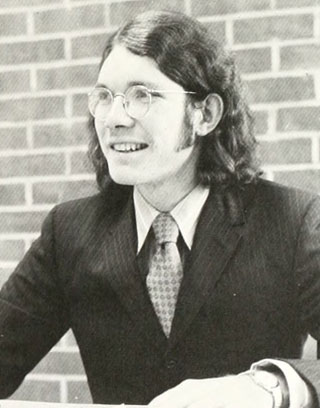
Thomas “Tommy” Clay was one of ECU’s most outstanding students in the 1970s, and then later, following his completion of medical school and a residency in psychiatry, one of ECU’s most distinguished medical faculty. A native of Greenville, Clay’s prominence as a student and as a faculty reflected well on the kind of opportunities that ECU as an institution made possible for many in eastern North Carolina.
After the successive resignations of the SGA vice president, David Edwards, and then the SGA president, Glenn Croshaw, Clay, previously a legislator, rose to prominence first, and briefly, as the interim vice president, and then, with Croshaw’s resignation, to the presidency, in the fall of 1971. His sudden ascent to the highest level of the SGA political structure was followed by his election to that office by a substantial two-thirds majority.
Clay’s most noteworthy achievement as SGA president was in resolving the visitation controversy that had, for over a year, resulted in campus upheaval, student demonstrations, a boycott of downtown Greenville businesses, and even student arrests. Working along with campus deans, James Mallory and Carolyn Fulghum, Clay spoke before the ECU Board of Trustees on behalf of a compromise known as “open house.” Rather than the full 24-7 visitation rights requested by the students the year before, Clay and others endorsed visitation privileges for students on Fridays, Saturdays, and Sundays, from noon until midnight. An Open House Council was proposed to supervise visitation practice. The Board of Trustees unanimously approved this compromise, effectively resolving the issue that had so divided the administration and the student body for well over a year. Through his efforts on this behalf, Clay became one of ECU’s most effective SGA presidents.
During his tenure as SGA president, Clay also supported a study of the campus infirmary in the hopes of updating and improving its services for students. Toward the end of his presidency, Clay also had a hand in revision of the SGA constitution. However, when it became known, through a Fountainhead piece, that there had been some changes in verbiage to the revised SGA constitution as presented to Chancellor Jenkins for final approval, Clay was called to task for those otherwise unauthorized changes. Although he ran for a second term as SGA president, the election, held shortly after the constitutional revision controversy came to light, resulted in Clay’s defeat. Nevertheless, the revised constitution was subsequently approved.
Clay was inducted into the Who’s Who Among American College and University Students in 1972. In addition to serving as SGA president, Clay was a member of the Society of Physics Students, the American Chemical Society, the Publications Board, the Honor Council, the League of Universal Brotherhood, and Sigma Tau Sigma fraternity.
Following his graduation in 1973 with degrees in chemistry, physics, and biochemistry, Clay completed, in 1979, his medical degree at the University of North Carolina at Chapel Hill. He subsequently did a residency in psychiatry at the North Carolina Memorial Hospital between 1980 and 1983, and then continued work at Memorial Hospital on a child psychiatry fellowship between 1983 and 1985. Clay then joined the Brody School of Medicine’s Department of Psychiatry and Behavioral Medicine. He serves as director of the Psychiatry Outpatient Clinic as well as a clinical associate professor.
Sources
- Clay, Tommy. “Clay views Jenkins’ Memo.” Fountainhead. Vol. III, no. 21. P. 6. https://digital.lib.ecu.edu/39594
- “Clay seeks reelection.” Fountainhead. Vol. 3, No. 40. March 23, 1972. P. 4. https://digital.lib.ecu.edu/39613
- “Clay claims two-thirds majority.” Fountainhead. Vol. III, no. 14. November 2, 1971. P. 1. https://digital.lib.ecu.edu/39587
- “Clay’s position safe: Petition dismissed.” Fountainhead. Vol. III, no 15. P. 1. https://digital.lib.ecu.edu/39588
- “Coalition collects two-thirds majority.” Fountainhead. Vol. 3, No. 42. March 29, 1972. P. 1. https://digital.lib.ecu.edu/39615
- “Dismayed at resignations SGA President expresses opinions.” Fountainhead. Vol. 3, no. 11. October 21, 1971. P. 2. https://digital.lib.ecu.edu/39584
- “ECU Trustees grant open house.” Fountainhead. Vol. III, no. 13. October 28, 2019. P. 1. https://digital.lib.ecu.edu/39586
- “Executive Council Witnesses New Student Unity.” Buccaneer. 1972. P. 168. https://digital.lib.ecu.edu/15323
- Parrish, Bruce. “Clay defends constitution.” Fountainhead. Vol. 3, no. 43. April 11, 1972. P. 1. https://digital.lib.ecu.edu/39616
- Parrish, Bruce. “Constitution discrepancies found.” Fountainhead. Vol. 3, no. 40. March 23, 1972. P. 1. https://digital.lib.ecu.edu/39613
- Parrish, Bruce. “‘Controversial’ constitution approved.” Fountainhead. Vol. 3, no. 44. April 13, 1972. P. 1. https://digital.lib.ecu.edu/39617
- “SGA Authorizes infirmary inquiry.” Fountainhead. Vol. 3, no. 34. February 22, 1972. P. 2. https://digital.lib.ecu.edu/39607
- “SGA President Croshaw Resigns.” Fountainhead. P. 1. Vol. 3, no. 9. October 14, 1971. P. 1. https://digital.lib.ecu.edu/39582
- “Sigma Tau Sigma.” Buccaneer. 1972. Pp. 370-71. https://digital.lib.ecu.edu/15323
- “Thomas H. Clay, Greenville, N.C.” Buccaneer. 1972. P. 382. https://digital.lib.ecu.edu/15323
- “Thomas H. Clay, M.D.” Brody School of Medicine: Department of Psychiatry and Behavioral Medicine. http://www.ecu.edu/cs-dhs/psychiatry/clayT.cfm
- “Thomas Howard Clay.” Buccaneer. 1972. P. 99. https://digital.lib.ecu.edu/15323
Citation Information
Title: Thomas "Tommy" H. Clay
Author: John A. Tucker, PhD
Date of Publication: 6/11/2019